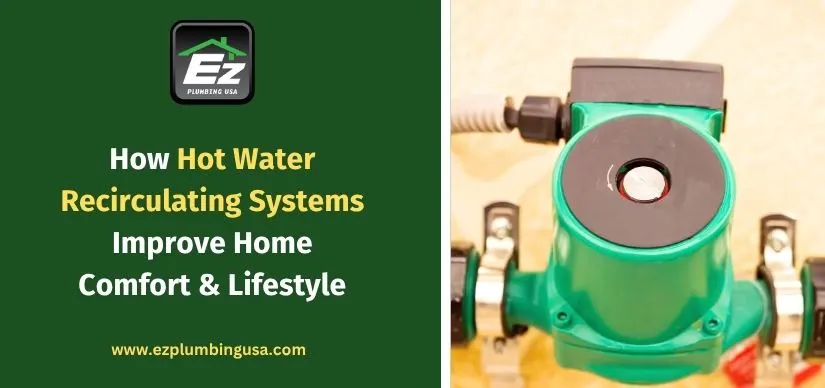How Hot Water Recirculating Systems Improve Home Comfort & Lifestyle
Views : 606

In our fast-paced world, speed-oriented convenience and efficiency are what we as modern-day living beings demand. A Hot Water Recirculating System is an introduction to a very smart plumbing solution which gives you instant access to hot water, thus improving your comfort at the same time, it saves water and energy. At the time of remodeling your home or improving your plumbing, this system is a game-changer. What it does is it gives you hot water right away, which in turn improves the flow of your lifestyle, conserves water, and also reduces energy costs, which are very much the elements of present-day home improvement.
What does a Hot Water Recirculating System do?
A Hot Water Recirculation System is a plumbing solution which keeps the hot water moving through your pipes, thus it is always at your disposal when you turn on the faucet. In traditional plumbing you wait for the water to heat up which in the meantime wastes gallons of water. With a recirculation system hot water is at your fingertips in seconds.
These systems are either in a constant cycle of pushing hot water through the plumbing system or they are set to come on when you turn a switch or which is activated by a sensor. What this does is it forces water in your pipes to go back to the heater for reheat which in turn is put back into the system, which at the same time reduces waste and ensures that you get hot water out to your fixtures immediately.
Types of Plumbing Recirculation Systems
There are mainly three types of plumbing recirculation systems:
- Dedicated Return Line Systems: These systems use a separate pipe to loop hot water back to the water heater. They are commonly installed in new homes or major remodels where rerouting pipes is feasible.
- Under-Sink Retrofit Systems: Ideal for existing homes, these install under sinks and use the cold water line for return flow. They’re budget-friendly and don’t require re-piping.
- Gravity Fed Systems: These systems rely on natural convection for circulation, making them energy-efficient but typically slower and less effective in larger homes.
Each option is tailored to different plumbing setups and home sizes. Choosing the right system depends on your home's design, water heater location, and overall plumbing layout.
Benefits of Installing a Hot Water Recirculating System
A Hot Water Recirculating System offers a variety of advantages that improve everyday living:
- Instant Hot Water: Eliminates the need to wait, providing immediate comfort.
- Water Conservation: Reduces water waste by circulating unused hot water back to the heater.
- Energy Efficiency: Less water heating time equals lower energy consumption.
- Convenience: Makes daily tasks like showering and washing dishes faster.
- Cost Savings: Reduced utility bills due to lower water and energy usage.
- Long-Term Value: Adds resale value to your home and aligns with energy-efficient property trends.
How Water Recirculation Pumps Work
A Water Recirculation Pump is the core component of the system. Installed near the water heater or under sinks, it propels hot water through the pipes continuously or on demand. Many models come with timers, motion sensors, or thermostats to optimize performance and efficiency.
Key Features of a Water Recirculation Pump:
- Timer-Based Operation: Allows scheduling of pump activity during peak usage hours to save energy.
- Temperature Sensors: Maintain consistent water temperature without overheating.
- Motion Detectors: Trigger pump action only when needed, maximizing efficiency.
These pumps help maintain the flow of hot water and avoid stagnant cooling, improving both energy use and comfort.
Installation Considerations
Before installing a Hot Water Recirculating System, consider the following:
- Plumbing Layout: Determine if your home supports a dedicated return line or requires a retrofit system.
- Energy Source: Choose a pump that works with your water heater type (electric, gas, solar).
- Pump Type: Options include continuous circulation, timer-based systems, and on-demand pumps.
- Cost: Installation costs typically range from $200 to $800, depending on system complexity.
- Professional vs. DIY: While some homeowners may choose DIY kits, professional installation is recommended for optimal performance and warranty protection.
Maintenance Tips for Longevity
Maintaining your plumbing recirculation system ensures long-lasting efficiency:
- Annual Inspections: Check for leaks, corrosion, or unusual noises.
- System Flushing: Mineral deposits can clog pipes; flush the system periodically to maintain flow.
- Pump Testing: Verify pump operation through manual testing or sensor calibration.
- Part Replacement: Replace faulty sensors, pumps, or valves as needed.
Proper upkeep extends the life of your system and helps retain its performance year-round.
Environmental Benefits
A Hot Water Recirculating System also supports eco-friendly living:
- Saving Water: Reduces the number of gallons wasted while waiting for hot water.
- Energy Conservation: Less heating time means reduced gas or electricity use.
- Lower Carbon Footprint: Efficient energy and water use help decrease overall environmental impact.
- Compliance with Green Building Codes: Some jurisdictions even offer incentives or rebates for installing water-saving systems.
Is It Right for Your Home?
Determining if a Hot Water Recirculating System is right for you depends on your household needs:
- Large Homes: If your bathroom is far from the water heater, this system significantly improves hot water delivery time.
- Busy Families: For households with high water usage, the time and water savings are substantial.
- Eco-Conscious Homeowners: If sustainability is your goal, reducing water and energy waste is a major win.
Common Misconceptions
Some myths surrounding hot water recirculating systems:
- They Use Too Much Power: Modern pumps are extremely efficient and often use less power than a light bulb.
- They’re Expensive: While upfront installation costs exist, the long-term utility savings and rebates often outweigh them.
- They’re Complicated: With retrofit kits and timer-based pumps, many systems are easy to use and require minimal maintenance.
Real-World Applications
Homeowners across California, especially in larger homes or multi-level houses, have experienced the benefits of recirculating systems. Instant hot water in every bathroom or kitchen saves time during morning routines and evening cleanups. It’s also useful for elderly residents or those with mobility concerns, as it prevents long waits and hot water burns from inconsistent flow.
Future Trends in Hot Water Circulation
Emerging technologies in Hot Water Recirculating Systems include:
- Smart Pumps: Wi-Fi-connected devices that integrate with home automation systems.
- AI-Powered Timers: Learn your usage habits and auto-optimize the pump’s schedule.
- Solar Integration: Combining with solar water heaters for even lower energy consumption.
These trends are making systems smarter, greener, and more user-friendly, expanding their appeal to homeowners across all demographics.
Final Thoughts
Integrating a Hot Water Recirculating System into your home isn’t just about convenience; it’s about creating a more efficient, sustainable, and comfortable lifestyle. From saving time and water to reducing utility bills, this modern plumbing upgrade pays for itself over time. With rising utility costs and growing environmental awareness, now is the perfect time to make the switch.
Call Us Today
Ready to enjoy the benefits of a Hot Water Recirculating System? Contact EZ Plumbing USA now for professional installation, expert advice, and top-tier service. Let us help you transform your home’s plumbing for greater comfort and efficiency.
In this area we serve: https://goo.gl/maps/et6kHzTuuDqN8WzDA
FAQ'S
1. How does a hot water recirculating system save water?
It eliminates the need to let water run while waiting for it to warm up, reducing wasted gallons daily. Instead, hot water is instantly available, helping conserve water.
2. Can I install a hot water recirculation system in an old home?
Yes, under-sink retrofit models are designed for older homes without dedicated return lines. They work using the cold-water line, making installation simple and non-invasive.
3. Do water recirculation pumps use a lot of electricity?
No. Most pumps are energy-efficient and consume minimal electricity. Timer-based or sensor-activated models further minimize energy usage.
4. Are there any downsides to a hot water recirculating system?
Minor downsides include installation costs and potential maintenance. However, the long-term benefits in convenience, savings, and efficiency outweigh these concerns.
5. How long does it take to install a hot water recirculation system?
Professional installation typically takes 2 to 4 hours, depending on your home’s plumbing layout and the type of system chosen.

.jpg)


